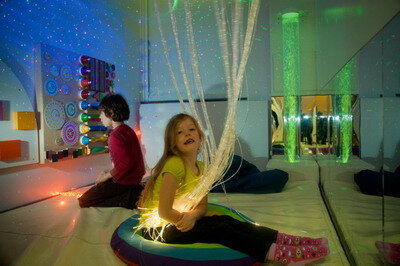Benefits of Sensory Stimulation for Autism

As more people are diagnosed with autism there is an increasing need to find techniques and tools that help people deal with their symptoms. One area of investigation that has been promising is sensory stimulation. This article will help you understand what autism is and how sensory stimulation can help people with autism lead their best lives.
What is Autism?
Autism Spectrum Disorder, or ASD is a very broad and poorly understood term. This has a lot to do with the way that autistic people have been portrayed in popular media. Generally speaking, Autism means that a person suffers from challenges with social skills, repetitive behaviors, speech, and non-verbal communication.
This condition is increasingly diagnosed in children and adults. Recent figures indicate that as many as 1 in 59 children are diagnosed with an autism spectrum disorder. While males are more commonly diagnosed than females, this disorder can affect anyone. It doesn’t follow any ethnic or socioeconomic pattern.
The increasing rate of autism diagnosis has led to a scramble for effective treatment options. While there is still no treatment that can eliminate autistic symptoms in an individual, there are methods and tools to help individuals cope with their symptoms.
One of the most promising tools is sensory stimulation.
What is Sensory Stimulation?
Sensory stimulation is a broad term that can refer to a number of specific techniques. Generally speaking, sensory stimulation is the act of using some method or tool to provide sensory input for someone. This can take the form of any sensory input, including light, sound, smell, touch, vestibular and taste. Touch, light, and vestibular are the most commonly used sensory inputs when it comes to options for improving ASD symptoms with sensory stimulation.
How can Sensory Stimulation Help People with Autism?
Research connects problems processing sensory information to many autistic symptoms. Some individuals may experience overstimulation, or sensory overload, while others experience under-stimulation. Both of these conditions fall under the category of a sensory modulation disorder.
People that experience overstimulation, or hyper-reactivity, will respond to sensory inputs that most people won’t notice. This can cause distractions and make it hard to focus on lessons and homework for children, and work and other required tasks as adults. This condition makes it difficult to pay attention to any one source of stimulation because of the constant stream of sensory data.
Individuals that experience hypo-reactivity will fail to respond to sensory stimuli. For example, an office worker may miss an alarm to go to a meeting and continue tweaking an email. A child may fail to come in from recess and continue swinging on a swing. Even those that can notice and respond to the stimuli will have difficulty transitioning away from their current focus. That means a worse performance in the meeting or the classroom.
Research shows that there are certain forms of stimulation that can help people with ASD. The stimming from these toys can soothe individuals and/or act as a stable center that can help them organize the information they’re receiving. Put more simply, sensory stimulation can help people with ASD focus and perform better.
There are categories of effects that sensory stimulation can have on people with ASD. These categories are effects on the body and effects on the mind.
Physical Responses to Sensory Stimulation
Physical responses depend largely on the state of someone’s nervous system. We see this all the time in our day to day lives. If you are feeling on edge, then you are more likely to respond aggressively or forcefully to situations. Your body also reacts. Heartrate and breathing go up, as does blood pressure. The body places itself in fight or flight mode. This physical state has dramatic impacts on mood and behavior.
In the same way, a low nervous system response can also dictate how your body feels. For example, someone may be reluctant to change the TV channel even though they aren’t interested or enjoying the program they arre currently watching. This can make individuals seem lazy, lethargic, or uncaring.
For hyper-reactive individuals, the world is a constant deluge of information. Much of it is useless noise that needs to be sorted through to find the important details. This can lead to a heightened nervous system state, with an individual always on edge and feeling like they have a million things going on all the time. The result is a greater difficulty concentrating, which causes problems at work, school, and home.
Emotional and Intellectual Responses to Sensory Stimulation
Emotional and intellectual responses to sensory stimulation mirror the physical responses. This is because the state of your nervous system also affects your state of mind. This is a two-edged sword, as it means any physical benefits or drawbacks someone experiences from sensory stimulation are mirrored emotionally and intellectually.
Problems processing sensory information are associated with a number of difficulties, including loneliness and anxiety in adults and children. Research also suggests that these feelings can exacerbate other issues that are common with ASD diagnoses. These feelings also make successful interventions and coping strategies all the more necessary.
One of the biggest intellectual issues for people that are hypo or hyper reactive is focus. Hyper-reactive individuals will try to focus on everything at once, making it hard to focus on any one thing. This can make them seem scattered and disorganized. It can also make them feel overwhelmed as they are constantly pulled in multiple directions towards different sources of stimulation.
In the same way, hypo-reactive individuals will remain focused on the stimulation they enjoy and will have a hard time transitioning to different forms of stimulation. This can cause people to seem distracted, lazy, or uncaring. This can make hypo-reactive individuals feel attacked, overwhelmed, and confused.
Understanding Sensory Stimulation and ASD
It may seem that sensory stimulation is one of the worst things for people with ASD. However, understanding how sensory stimulation causes different responses in people allows individuals, doctors, and occupational therapists to come up with strategies that use sensory stimulation to help people with ASD lead better lives. One of the most popular approaches to sensory stimulation in people with ASD is called sensory integration.
Sensory Integration
Sensory Integration, also called Occupational Therapy using Sensory Integration or OT-SI, is a form of therapy that helps individuals with ASD adapt the way they receive, process, and react to stimulation. It can be an excellent way for people with ASD to develop the skills and behaviors necessary to live a better, more functional life.
These strategies work best when they are incorporated into an individual’s daily life. That could mean something like squeezing a stress ball during car rides to help deal with the barrage of stimulation such a trip entails. These activities should be individualized so as to provide the maximum benefit. Occupational therapists excel at recognizing these issues and developing strategies for dealing with them.
OT-SI is distinct from sensory strategies which calm people down but don’t change brain function. For example, things like weighted blankets and compression vests can produce a calming sensory effect, but they do not provide long-term change.
However, that’s not to say that sensory tools like weighted blankets and compression vests have no value. These tools are still an important resource that helps people with ASD or other sensory processing disorders to feel better in the moment.
Additionally, like previous examples indicate, temporary stimulation relief can become effective sensory stimulation strategies if they are used in a consistent way with the goal of normalizing and adapting the individual to different sensory stimulations. These processes and methods should be developed in conjunction with appropriate medical professionals.

Sensory Stimulation #1 - Texture
There are several ways to increase sensory input for sensory integration therapies. The Naboso Mat is one popular method that integrates texture and tactile stimulation. The two point discrimination texture of the Naboso Mat stimulates the skin on the palms of the hands and bottom of the feet.
Another common method for providing tactile stimulation for sensory integration are things like stress balls or fidget toys for hand stimulation.
Sensory Stimulation #2 - Vestibular
Although tactile stimulation may be one of the most common sensory pathways, some individuals prefer stimulation from vestibular movements, or movements which stimulate the inner ear.
This is achieved by swinging or rocking back and fourth. There are also products designed to provide vestibular stimulation like specialized swings.
Sensory Stimulation #3 - Proprioceptive
A final common approach to increasing stimulation is through proprioceptive or joint input. Weighted blankets and apparel are one of the most common methods for increasing input and calming an over-stimulated child.
Studies suggest the weighted apparel and blankets help to re-create the comforted environment of being in the womb or in a person’s embrace. The result is a down-regulation of the sympathetic nervous system out of fight or flight.
Final Thoughts on ASD and Sensory Stimulation
As you can see, understanding sensory stimulation is a key part of understanding individuals with Autism Spectrum Disorder. Using sensory integration techniques, it is possible to use the unique way that individuals with ASD experience sensory information to help them perform better at school, work, and home. Additionally, being aware of how you or someone you care about interprets sensory information can facilitate easier and more efficient communication, make it easier to set and achieve goals, and improve the overall quality of life.
Talk to a doctor or occupational therapist to see if sensory integration or sensory stimulation strategies can help you or someone you care about. This information can help you identify products and processes that can help you cope with sensory stimulation disorders.